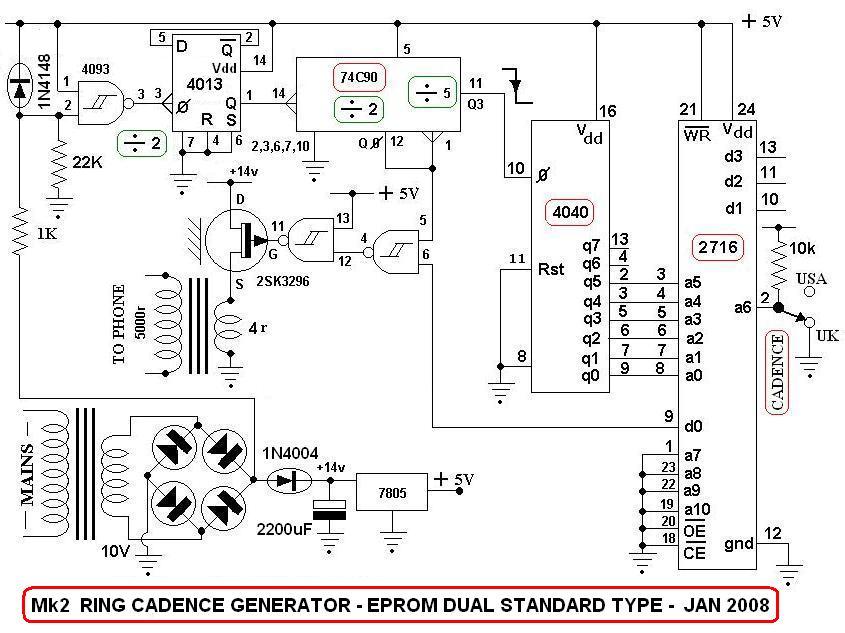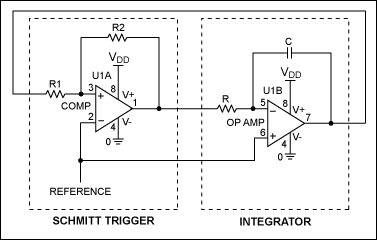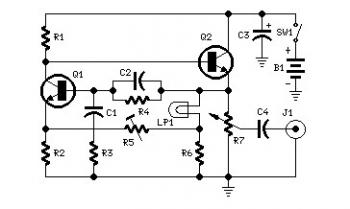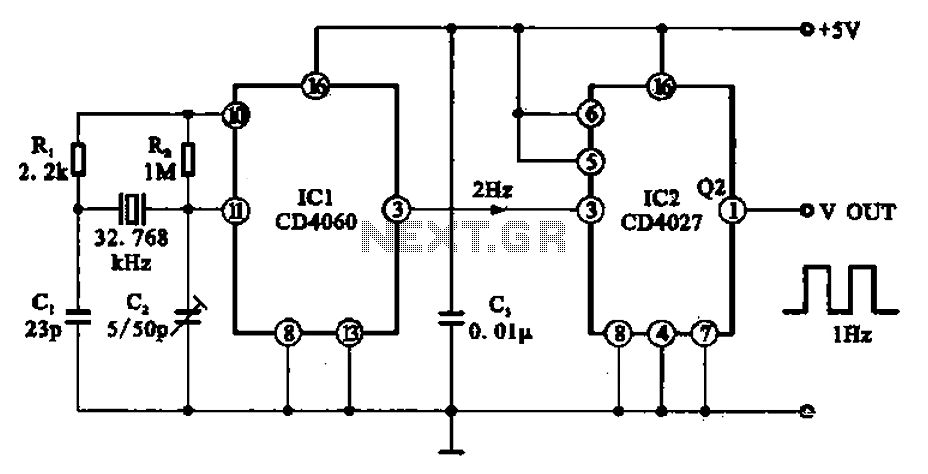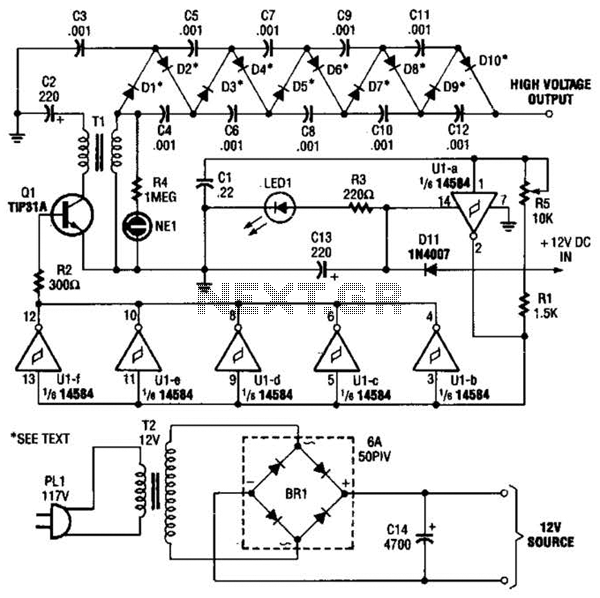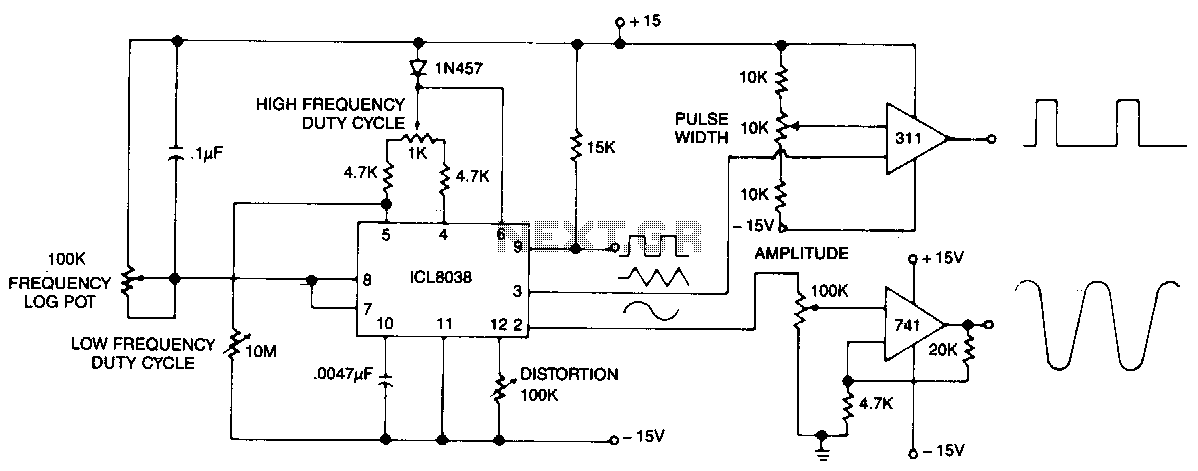
Function generator
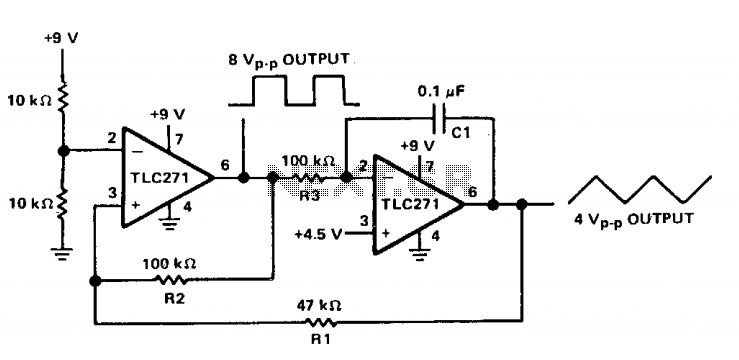
The circuit features both square-wave and triangle-wave outputs. The left section operates similarly to a comparator circuit that employs positive feedback for hysteresis. The inverting input is biased at half the Vcc voltage using resistors R4 and R5. The output is fed back to the non-inverting input of the first stage to regulate the frequency. The amplitude of the square wave is determined by the output swing of the first stage, measuring 8 V peak-to-peak. The second stage functions as an op-amp integrator. The resistor R3 serves as the input component, while capacitor C1 acts as the feedback element. The ratio of R1 to R2 establishes the amplitude of the triangle wave in relation to the square-wave output. The frequency of oscillation for both waveforms can be calculated using a specific equation.
The described circuit is a waveform generator capable of producing square and triangle waves, commonly utilized in various applications such as signal processing, audio synthesis, and control systems. The first stage, which mimics a comparator, utilizes positive feedback to create hysteresis, ensuring stable switching between high and low states. This configuration minimizes noise susceptibility and enhances the reliability of the output signals.
The inverting input's biasing at half the Vcc is crucial for determining the threshold levels at which the circuit toggles between its output states. The feedback mechanism, where the output is routed back to the non-inverting input, is integral for controlling the oscillation frequency. This feedback loop allows for precise frequency modulation, which is essential in applications where timing is critical.
The amplitude of the square wave output, specified as 8 V peak-to-peak, indicates the maximum voltage swing of the first stage, which is vital for ensuring the generated signals are robust enough for downstream applications. The second stage's role as an op-amp integrator allows it to convert the square wave into a triangle wave, providing a linear ramp signal that can be advantageous in various signal processing tasks.
Resistor R3, as the input element, plays a significant role in determining the circuit’s response to input signals, while capacitor C1, serving as the feedback element, influences the integrative properties of the second stage. The relationship between resistors R1 and R2 is critical, as it directly affects the amplitude of the triangle wave in relation to the square-wave output, allowing for flexibility in waveform shaping.
The formula governing the frequency of oscillation for both waveforms is essential for designers and engineers to understand, as it allows for precise control over the generated frequencies, ensuring they meet the requirements of the specific application. Overall, this circuit exemplifies the integration of comparator and integrator functionalities to produce versatile waveform outputs.The circuit has both square-wave and triangle-wave output. The left section is similar in function to a comparator circuit that uses positive feedback for hysteresis. The inverting input is biased at one-half the Vcc voltage by resistors R4 and R5. The output is fed back to the non-inverting input of the first stage to control the frequency. The amplitude of the square wave is the output swing of the first stage, which is 8 V peak-to-peak. The second stage is basically an op amp integrator. The resistor R3 is the input element and capacitor Cl is the feedback element. The ratio R1/R2 sets the amplitude of the triangle wave, as referenced to the square-wave output. For both waveforms, the frequency of oscillation can be determined by the equation: 🔗 External reference
The described circuit is a waveform generator capable of producing square and triangle waves, commonly utilized in various applications such as signal processing, audio synthesis, and control systems. The first stage, which mimics a comparator, utilizes positive feedback to create hysteresis, ensuring stable switching between high and low states. This configuration minimizes noise susceptibility and enhances the reliability of the output signals.
The inverting input's biasing at half the Vcc is crucial for determining the threshold levels at which the circuit toggles between its output states. The feedback mechanism, where the output is routed back to the non-inverting input, is integral for controlling the oscillation frequency. This feedback loop allows for precise frequency modulation, which is essential in applications where timing is critical.
The amplitude of the square wave output, specified as 8 V peak-to-peak, indicates the maximum voltage swing of the first stage, which is vital for ensuring the generated signals are robust enough for downstream applications. The second stage's role as an op-amp integrator allows it to convert the square wave into a triangle wave, providing a linear ramp signal that can be advantageous in various signal processing tasks.
Resistor R3, as the input element, plays a significant role in determining the circuit’s response to input signals, while capacitor C1, serving as the feedback element, influences the integrative properties of the second stage. The relationship between resistors R1 and R2 is critical, as it directly affects the amplitude of the triangle wave in relation to the square-wave output, allowing for flexibility in waveform shaping.
The formula governing the frequency of oscillation for both waveforms is essential for designers and engineers to understand, as it allows for precise control over the generated frequencies, ensuring they meet the requirements of the specific application. Overall, this circuit exemplifies the integration of comparator and integrator functionalities to produce versatile waveform outputs.The circuit has both square-wave and triangle-wave output. The left section is similar in function to a comparator circuit that uses positive feedback for hysteresis. The inverting input is biased at one-half the Vcc voltage by resistors R4 and R5. The output is fed back to the non-inverting input of the first stage to control the frequency. The amplitude of the square wave is the output swing of the first stage, which is 8 V peak-to-peak. The second stage is basically an op amp integrator. The resistor R3 is the input element and capacitor Cl is the feedback element. The ratio R1/R2 sets the amplitude of the triangle wave, as referenced to the square-wave output. For both waveforms, the frequency of oscillation can be determined by the equation: 🔗 External reference
